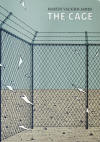The Cage
Martin Vaughn-James’ The Cage, a graphic novel originally published in 1975, was re-released by Coach House Books at the end of last year in a new edition which includes introductions from the author and Canadian cartoonist Seth. Interestingly, both artists try to explain what The Cage is ultimately about in their introductions.
Martin Vaughn-James’ The Cage, a graphic novel originally published in 1975, was re-released by Coach House Books at the end of last year in a new edition which includes introductions from the author and Canadian cartoonist Seth. Interestingly, both artists try to explain what The Cage is ultimately about in their introductions.
“What is the cage?” Seth asks. “I don’t think there’s one correct answer.”
Meanwhile, author/artist Vaughn-James says, “Fuelled by the basically simple idea of murdering the ‘character’ and of recreating or disposing of the evidence, the engine is cranked up and set in motion.” But he also seems at a loss to describe what exactly the project intends to convey, when he continues, “I have no satisfactory answer, an author orphaned by his own creation, baffled and pleasantly surprised to see that the monster has once again arisen.”
It is true that The Cage is an oddity in the realm of graphic novels, but I was surprised to find it presented with so many prefatory warnings; both introductions seem to attempt to warn off readers who might be disappointed by the book’s lack of plot. Perhaps it would be helpful to readers and to the author to class the book as a work of “graphic poetry” rather than as a graphic novel. Because, no, the book does not have a plot, or characters, but the progression of the images is affecting, and the interaction between the images and the text operates like lyric poetry.
The images are highly detailed, and they portray unpopulated spaces—rooms, buildings, and so on—which are whole in one frame and then in a state of disarray or decay elsewhere in the book. The unpopulated spaces are juxtaposed with images of spindled blankets and clothing, blank sheets of paper, and bulbous black splotches that in some contexts appear to be ink or oil, and in others appear to be blood. The images are ordered so that they possess a tension that increases bit by bit as the book progresses, as the images move from imposing cityscapes to images of a bundle of sheets and clothing bound by ropes and held pinned by bricks, suggesting nothing less than a person being drawn and quartered. The abstract suggestion is quite disturbing, and the book’s final pages—portraying a building in ruins and then a return to the images of blank pages and a desolate chain link cage—effectively release tension.
Occasionally the text describes or otherwise directly corresponds to the images, but more often the text moves independently of the images, describing scenes that seem to have occurred at earlier points in the book, or are soon to occur. Time is both disjointed and static. Every “event” seems to be simultaneously occurring and frozen in frame, so as viewers, we feel suspended from a normal progression of events. Seth’s introduction refers to the book’s text as a “voice over,” and this is an apt description, although at times the text also itself reads like poetry:
a frozen geometry of mutilated props a silent
drama a wingless crippled and carnivorous
repertoire of shrieks . . .
The tone is nightmarish, dystopian; the book moves beyond story and offers readers an experience that is intuitively felt, rather than intellectually understood. As both introductions seem to preemptively defend against, The Cage is the kind of book that will puzzle and probably frustrate readers who expect a traditional graphic novel.
This is not to say that it isn’t worthwhile to strive to come to an understanding about what a book is “about,” or that it isn’t good practice to try to decode language in difficult books. But doing so can deprive readers of the essential experience of language, of the way words (or images) in a particular arrangement make us feel. The Cage is not a traditional graphic novel, and it is likely to frustrate many readers, but it is also quite good. The effects Vaughn-James creates through his artwork and the interplay between the images and the text are vivid, disturbing, and ultimately intriguing.





